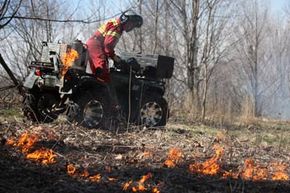After the Forest Fire: Benefits to Animals
Although some animals become injured or die from forest fires, most survive. The majority of animals can smell a fire, even when it's quite small, from miles away. Some animals, such as deer and bear, will flee the area while others, such as insects and small mammals, will burrow into the ground until the flames pass [sources: James, National Park Service].
And even though some animals may be displaced during a forest fire, the scorched earth will eventually provide an ideal new home for others -- one that is full of thicker vegetation fed by nutrient-rich soil.
Advertisement
That's because forest fires can create an all-you-can-eat buffet. More than 40 different kinds of insects, for example, will eat their way through fire-ravaged territory as they burrow into the wood that remains [source: Family on Bikes].
There's even a species of beetles that waits for forest fires, using heat sensors to come in from miles away to eat injured trees. These fattened insects then become food themselves as birds hunt for a feast all their own. The shrubs and grasses fertilized by fire-created nutrients will grow lushly; soon, deer and other grazing wildlife (even mice) will make a meal of them. Then, predators -- coyotes, mountain lions, bobcats, wolves and bears -- will get their fill of prey, too.
Years later, when the forest's growth has created a dark and damp interior framed by a leafy overhead canopy, the forest's remaining residents will move back in. Deep forest plants like mosses, lichens and animals like pine martens, spotted owls, and woodland caribou will once again call it home [sources: James].
Author's Note: How does a forest fire benefit living things?
Without fire, early humans would have been chilly vegetarians (it would have been difficult to subsist on dinosaur carpaccio during the long, cold winters, after all). Although we've come to rely on fire for survival and comfort, fire also can sweep through heavily wooded areas and threaten lives or livelihood. Still, there are benefits. These fires eat their way through underbrush and never reach the tops of the tallest trees. After the fire dies out, it leaves the forest clear of underbrush that chokes out new growth, making it ready for a new generation of native plants.
Related HowStuffWorks Articles
Sources
- Eilperin, Juliet. "Benefits of Planned Forest Fires Are Cited." The Washington Post. July 31, 2005. (April 12, 2013) http://www.washingtonpost.com/wp-dyn/content/article/2005/07/30/AR2005073000999.html
- Family On Bikes. "How Fires Benefit Wildlife." (April 10, 2013) http://familyonbikes.org/educate/lessons/animals_wildfires.htm
- James, Michael. "Animals Co-Exist with Wildfires." ABC News. Aug. 16, 2000. (April 10, 2013) http://abcnews.go.com/Technology/story?id=119700
- Kansas Department of Health and Environment. "Kansas Prescribed Fire Emissions." (April 12, 2013) http://www.kdheks.gov/bar/reghaze/Appendix_7_3.pdf
- Kansas Department of Health and Environment. "Kansas Prescribed Fire Emissions." (April 17, 2013) http://www.kdheks.gov/bar/reghaze/Appendix_10_4.pdf
- Krock, Lexi. "The World on Fire." PBS. 2000. (April 10, 2013) http://www.pbs.org/wgbh/nova/fire/world.html
- National Atlas. "National Fire Plan." 2004. (April 10, 2013) http://nationalatlas.gov/mld/firplnp.html
- National Geographic. "Wildfires." (April 10, 2013) http://environment.nationalgeographic.com/environment/natural-disasters/wildfires/
- National Park Service. "Wildland Fire: Fire Adaptation." (April 10, 2013) http://www.nps.gov/fire/wildland-fire/learning-center/educator-resources/lesson-plans/fire-adaptation.cfm
- Pacific Biodiversity Institute. "Fire Ecology." 2009. (April 10, 2013) http://www.pacificbio.org/initiatives/fire/fire_ecology.html
- Porter, Michael. "How to Conduct a Prescribed Burn." February 2000. The Samuel Roberts Noble Foundation. (April 17, 2013) http://www.noble.org/ag/wildlife/prescribedburn/
- Society of American Foresters. "The State of America's Forests." 2006. (April 12, 2013) http://www.safnet.org/publications/americanforests/StateOfAmericasForests.pdf
- U.S. Forest Service. "The U.S. Forest Service: An Overview." 2001. (April 12, 2013) http://www.fs.fed.us/documents/USFS_An_Overview_0106MJS.pdf
- Western Forestry Leadership Coalition. "The True Cost of Wildfire in the Western U.S." April 2010. (April 10, 2013) http://www.blm.gov/or/districts/roseburg/plans/collab_forestry/files/TrueCostOfWilfire.pdf
